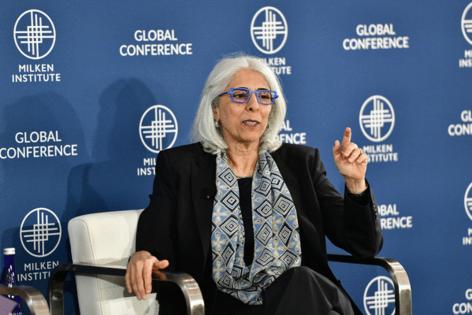Research funding faces crunch time post-election
Published in News & Features
WASHINGTON — The U.S. needs to “go big” on research and development in artificial intelligence and advanced technologies by overcoming budget caps and other spending concerns, according to the White House’s top science adviser.
Arati Prabhakar, director of the White House Office of Science and Technology Policy, said that given China’s technological rise and the potential of AI to be a disruptive force, increased R&D spending is necessary to keep America competitive.
“American R&D does not thrive unless we have the federal component to lay this foundation of basic research, to educate the students that are going to feed into all of these industries,” Prabhakar said at an American Enterprise Institute event on Oct. 8.
Boosting federal R&D spending isn’t going to be easy with concerns rising about budget deficits, regardless of who wins in November, according to analysts tracking the issue. With that in mind, Prabhakar is touting the importance of this research for national security, as well as its key role advancing technologies in energy, environment, agriculture and beyond.
“The thing that I regret that I think we have not gotten done, but that this country certainly has to do … we have got to go big, and we aren’t yet taking as many big shots at really huge opportunities,” Prabhakar said.
She backs a proposal from a bipartisan group of lawmakers led by Senate Majority Leader Charles E. Schumer that calls for an annual spending of $32 billion on nondefense-related AI research. That could supercharge drug discovery and help find cures for “thousands of known diseases for which there’s no treatment,” she said.
Driven partly by fears that China could surpass the United States in technological leadership, federal R&D spending rose in the first half of the Biden administration, including through a 2022 law dubbed the CHIPS and Science Act that authorized $102 billion for the National Science Foundation over five years.
But since then, Congress capped nondefense discretionary spending to increases of no more than 1 percent annually. For fiscal 2025, the White House requested $203.7 billion in federal R&D, a slight bump from $200.3 billion enacted in fiscal 2024. The House has proposed $202.7 billion in fiscal 2025 and the Senate proposal stands at $200.9 billion, according to the American Association for the Advancement of Science, or AAAS.
The president’s request for the NSF in fiscal 2025 is far lower than the $16.7 billion that Congress authorized for the agency in the next fiscal year under the 2022 CHIPS law, which was intended to boost U.S. investment in basic scientific research and translate that into technological applications.
Meanwhile, China’s growth in overall R&D spending, including both government and business expenditures, averaged 14 percent per year from 2001 to 2021, according to AAAS.
Size of government
Making a case for boosting federal R&D is likely to be tough in the months ahead, according to Joanne Carney, the chief government relations officer at AAAS.
“There are issues at play that have nothing to do with science and technology,” Carney said in an interview. “There’s concerns about the deficit and how much we should be spending and the size of the government and how much we should be spending on discretionary programs.”
Debate over the provisions of the U.S. tax code implemented through a 2017 law that expire at the end of 2025 are likely to “push our issues of concern to the back burner,” Carney said, referring to R&D spending.
“The concern that we have is we’re sending signals, not only to competing nations but also to our allies, that we’re not taking investments in chips and science and in the innovation ecosystem seriously” if spending stalls, Carney said.
M. Anthony Mills, director at the Center for Technology, Science, and Energy at the American Enterprise Institute, a conservative think tank, said that “it’s difficult to know in the abstract what a MAGA R&D policy is going to look like” if Donald Trump is elected president, or if either chamber is Republican-controlled.
Although traditional GOP lawmakers are likely to abide by principles of fiscal conservatism and a hawkish stance toward China, “aspects of the MAGA right want to kind of rethink the role of the state,” Mills said in an interview.
The National Institutes of Health, which receives a substantial portion of the nondefense R&D spending, is likely to be in the cross hairs of pro-Trump Republicans, Mills said.
Republican lawmakers have said the NIH covered up its potential role in funding research that may have contributed to the development of the COVID-19 virus in a Chinese lab. Anthony Fauci, the former director of the NIH’s National Institute of Allergy and Infectious Diseases who’s since retired, has denied the allegations. For fiscal 2025, the NIH requested a budget of $50.1 billion.
For some pro-Trump Republican lawmakers, even defense-related R&D spending, which has traditionally seen strong Republican support, could “wind up being controversial in the same way that NIH has become controversial,” Mills said.
Despite bipartisan alarm about China’s technological rise, more pressing concerns about the role and size of government and budget deficits are likely to drive future federal R&D spending, Mills said.
©2024 CQ-Roll Call, Inc., All Rights Reserved. Visit cqrollcall.com. Distributed by Tribune Content Agency, LLC.







Comments